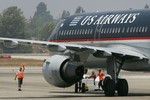We started this site based on the idea that things frequent travelers take for granted are still met with surprise by those who fly less often. Then…we received a letter:
There was a time in my life when I flew relatively often. I was experienced with quick and perfunctory security checkpoints. I knew to look for my paper ticket in the mail and be sure to bring it with me. Restrictions in carry-on? Well, no guns or bombs, but liquids, lighters, pocket knives- those were different times.
Recently, I had the occasion to fly for the first time in several years, and I found the experience rather different.
We know things are different now. Now, passengers are told to show up anywhere from 1.5 to 3.5 hours from time of departure. Not the same as this snip from a 1950s Mohawk Airlines Timetable(Click to Enlarge) where you had to check in 10 minutes before departure in the good old days before hijackings, bombs, etc. Or even the same as ten years ago, when it was 1 hour for domestic, 2 hours for international.
Blast from the past, aside…there was more…
Booking My Ticket
I was used to booking my ticket by calling each of the major airlines in sequence and wrangling different flights with each. “What if I come back Tuesday?”, “What if I fly out of Islip?” I’d then hold each ticket for 24 hours which gave me time to call additional airlines and try my hand with other agents at the same airline. A time consuming process, though at that time it was possible to get to a person. Of course, I looked down on other less savvy travelers who used travel agents to buy their tickets. Back then airlines paid generous commissions and travel agents would actually sell you just a ticket, not a vacation package or an experience. Still, if you wanted the best price, do-it-yourself was the way to go.
Nowadays, calling the airlines will get you an endless set of automated menus. There may be a person hidden in there somewhere, but your prize for finding him(and you deserve a prize) is a surcharge for booking on the phone. That is if you can understand his accent and his lack of knowledge of American geography doesn’t land you a flight from New York to Boston with a stop in St. Louis.
Faced with this, I went to the internet to book my ticket. But where to start? I could go to the individual airline websites, but that was as much work as calling them all. So perhaps a consolidator, like Travelocity, Orbitz or Expedia? But they don’t include all of the discount airlines, and I’m not into paying more than I have to. I finally discovered kayak.com, a meta-search engine which searches all of the above, and returned the results in a snazzy interface which allowed me to alter my query much more easily than the others.
Once I found my ticket, I clicked off to the airline website to book it. I could have bought it through Orbitz, but Kayak showed that it was several dollars more, and I couldn’t think of what value they might add. Buying the ticket was straightforward enough, but the next step confused me all over again.
Paper tickets are on the way out. This year, IATA announced they would cease printing paper ticket stock for airlines. This means that the issuing of paper tickets will now become a much more costly matter. Electronic ticketing has advantages….you can’t lose an electronic ticket. If you lose a paper ticket, you are in trouble as they have a monetary value. The only thing you can’t do with an electronic ticket is walk over to another airline and ask them to take it at face value when your carrier cannot transport you. But how likely are they to take it nowadays anyway?
Our author used Kayak…which is a metasearch engine. It searches travel sites and makes commissions by purchases made through the sites they refer to. We endorse Kayak, and keep its search box on our page, because Kayak by itself does not actually sell tickets. It is one of several sites of this nature, and the subject of a future post.
Next time…Part II…Receiving the Ticket.

